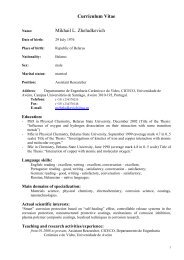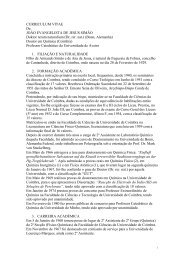XII Iberian Meeting of Electrochemistry XVI Meeting of the ...
XII Iberian Meeting of Electrochemistry XVI Meeting of the ...
XII Iberian Meeting of Electrochemistry XVI Meeting of the ...
You also want an ePaper? Increase the reach of your titles
YUMPU automatically turns print PDFs into web optimized ePapers that Google loves.
<strong>XII</strong> <strong>Iberian</strong> <strong>Meeting</strong> <strong>of</strong> <strong>Electrochemistry</strong> & <strong>XVI</strong> <strong>Meeting</strong> <strong>of</strong> <strong>the</strong> Portuguese Electrochemical Society PD 09<br />
Effect <strong>of</strong> chloride and sulphate ions on <strong>the</strong> electrochemical<br />
behaviour <strong>of</strong> an austenitic stainless steel, <strong>the</strong> H A Z and <strong>the</strong><br />
welded metal in phosphoric acid medium at different<br />
temperatures<br />
Blasco-Tamarit, E.; García-García, D.M.; Ibáñez-Ferrándiz, M.V.;<br />
García-Antón, J.<br />
Ingeniería Electroquímica y Corrosión (IEC). Departamento de Ingeniería Química y Nuclear.<br />
E.T.S.I.Industriales. Universidad Politécnica de Valencia. P.O. Box 22012, E-46071 Valencia.<br />
Spain.<br />
jgarciaa@iqn.upv.es<br />
Industrial phosphoric acid solutions are chemically complex and <strong>the</strong>ir analysis changes<br />
from one plant to ano<strong>the</strong>r, depending on <strong>the</strong> quality <strong>of</strong> phosphate ores and <strong>the</strong> process<br />
utilized. Phosphoric acid produced according to <strong>the</strong> wet process, in which <strong>the</strong> phosphate<br />
ores are attacked by sulphuric acid, is <strong>the</strong> most important <strong>of</strong> such chemicals. During <strong>the</strong><br />
wet process, impurities as chlorides and sulphides are incorporated to <strong>the</strong> phosphoric<br />
acid, which becomes this acid in <strong>the</strong> most aggressive industrial phosphoric acid. So that,<br />
severe corrosion problems on <strong>the</strong> equipments used in this industry take place. In this<br />
sense, <strong>the</strong> austenitic stainless steels are a good choice to be used in phosphoric media<br />
due to <strong>the</strong>ir high corrosion resistance.<br />
The objective <strong>of</strong> <strong>the</strong> this work was to study <strong>the</strong> effect <strong>of</strong> <strong>the</strong> impurities (chlorides and<br />
sulphates) on <strong>the</strong> electrochemical behaviour <strong>of</strong> a highly alloyed austenitic stainless steel<br />
(UNS N08031) used as base metal, <strong>the</strong> welded metal obtained by TIG (Tungsten Inert<br />
Gas) welding using a Nickel-base alloy (UNS N06059) as filler metal, and <strong>the</strong> Heat<br />
Affected Zone (HAZ) <strong>of</strong> <strong>the</strong> base metal. The materials have been tested in two solutions:<br />
pure 5.5 M phosphoric acid solution and 5.5 M phosphoric acid solution polluted with<br />
379.2 ppm <strong>of</strong> chloride ions and 2wt% <strong>of</strong> H 2 SO 4 . Tests were developed at 25 ºC, 40ºC,<br />
60ºC and 80ºC.<br />
Open Circuit Potential tests and potentiodynamic anodic polarization curves were<br />
carried out to obtain information about <strong>the</strong> electrochemical behaviour <strong>of</strong> <strong>the</strong> materials.<br />
Corrosion potentials and corrosion current densities were obtained from Tafel analysis.<br />
The critic potentials and <strong>the</strong> passivation current densities <strong>of</strong> <strong>the</strong> studied materials were<br />
also analysed.<br />
The most important influence <strong>of</strong> impurities was observed on <strong>the</strong> critic potential obtained<br />
from <strong>the</strong> potentiodynamic curves. More active values <strong>of</strong> critic potential were obtained in<br />
<strong>the</strong> polluted solution than in <strong>the</strong> pure solution. This fact means that <strong>the</strong> presence <strong>of</strong><br />
impurities makes <strong>the</strong> rupture <strong>of</strong> <strong>the</strong> passive film easier.<br />
Acknowledgments: We wish to express our gratitude to Programa de Apoyo a la Investigación y<br />
Desarrollo de la Universidad Politécnica de Valencia (PAID-06-09 and to <strong>the</strong> Ministerio de<br />
Asuntos Exteriores y Cooperación <strong>of</strong> Spain (PCI Mediterráneo C/8196/07, Ref. C/018046/08, and<br />
D/023608/09).<br />
September, 811, 2010. ISEL - Lisbon 91








